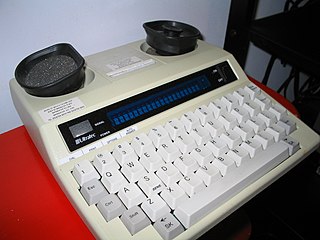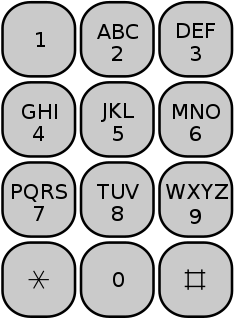Electronic data interchange (EDI) is the concept of businesses electronically communicating information that was traditionally communicated on paper, such as purchase orders and invoices. Technical standards for EDI exist to facilitate parties transacting such instruments without having to make special arrangements.
Iridium Communications Inc. is a publicly traded American company headquartered in McLean, Virginia. Iridium operates the Iridium satellite constellation, a system of 141 active satellites used for worldwide voice and data communication from hand-held satellite phones and other transceiver units. The Iridium network is unique in that it covers the whole Earth, including poles, oceans and airways, with 95 satellites launched so far. The satellites are frequently visible in the night sky as satellite flares, a phenomenon typically observed as short-lived bright flashes of light.

Wireless Markup Language (WML), based on XML, is a now-obsolete markup language intended for devices that implement the Wireless Application Protocol (WAP) specification, such as mobile phones. It provides navigational support, data input, hyperlinks, text and image presentation, and forms, much like HTML. It preceded the use of other markup languages now used with WAP, such as HTML itself, and XHTML.
X.500 is a series of computer networking standards covering electronic directory services. The X.500 series was developed by ITU-T, formerly known as CCITT, and first approved in 1988. The directory services were developed in order to support the requirements of X.400 electronic mail exchange and name lookup. ISO was a partner in developing the standards, incorporating them into the Open Systems Interconnection suite of protocols. ISO/IEC 9594 is the corresponding ISO identification.

A telecommunications device for the deaf (TDD) is a teleprinter, an electronic device for text communication over a telephone line, that is designed for use by persons with hearing or speech difficulties. Other names for the device include teletypewriter (TTY), textphone, and minicom.
The Serial Peripheral Interface (SPI) is a synchronous serial communication interface specification used for short distance communication, primarily in embedded systems. The interface was developed by Motorola in the mid 1980s and has become a de facto standard. Typical applications include Secure Digital cards and liquid crystal displays.
Tap, Taps, TAP or tapped may refer to:

Near-field communication (NFC) is a set of communication protocols that enable two electronic devices, one of which is usually a portable device such as a smartphone, to establish communication by bringing them within 4 cm (1.6 in) of each other.
Modbus is a serial communications protocol originally published by Modicon in 1979 for use with its programmable logic controllers (PLCs). Modbus has become a de facto standard communication protocol and is now a commonly available means of connecting industrial electronic devices. The main reasons for the use of Modbus in the industrial environment are:
The Open Mobile Alliance (OMA) is a standards body which develops open standards for the mobile phone industry. It is not a formal government-sponsored standards organization like the ITU, but a forum for industry stakeholders to agree on common specifications for products and services.
The Secure Communications Interoperability Protocol (SCIP) is a multinational standard for secure voice and data communication, for circuit-switched one-to-one connections, not packet-switched networks. SCIP derived from the US Government Future Narrowband Digital Terminal (FNBDT) project after the US offered to share details of FNBDT with other nations in 2003. SCIP supports a number of different modes, including national and multinational modes which employ different cryptography. Many nations and industries develop SCIP devices to support the multinational and national modes of SCIP.
FLEX is a communications protocol developed by Motorola and used in many pagers. FLEX provides one-way communication only, but a related protocol called ReFLEX provides two-way messaging.
Wireless Village is a set of specifications for mobile instant messaging and presence services. It is intended to be a standard for cellphones and mobile devices to use these services across platforms.
The Open Mobile Terminal Platform (OMTP) was a forum created by mobile network operators to discuss standards with manufacturers of mobile phones and other mobile devices. During its lifetime, the OMTP included manufacturers such as Huawei, LG Electronics, Motorola, Nokia, Samsung and Sony Ericsson.
CANopen is a communication protocol and device profile specification for embedded systems used in automation. In terms of the OSI model, CANopen implements the layers above and including the network layer. The CANopen standard consists of an addressing scheme, several small communication protocols and an application layer defined by a device profile. The communication protocols have support for network management, device monitoring and communication between nodes, including a simple transport layer for message segmentation/desegmentation. The lower level protocol implementing the data link and physical layers is usually Controller Area Network (CAN), although devices using some other means of communication can also implement the CANopen device profile.
In computer networking, a port is an endpoint of communication. Physical as well as wireless connections are terminated at ports of hardware devices. At the software level, within an operating system, a port is a logical construct that identifies a specific process or a type of network service. Ports are identified for each protocol and address combination by 16-bit unsigned numbers, commonly known as the port number. Inbound packets are received, and the port number in the header is used to decide which application is to be passed the packets.
Wireless Application Protocol (WAP) is a technical standard for accessing information over a mobile wireless network. A WAP browser is a web browser for mobile devices such as mobile phones that uses the protocol. Introduced with much hype in 1999, WAP achieved some popularity in the early 2000s, but by the 2010s it had been largely superseded by more modern standards. Most modern handset internet browsers now fully support HTML, so they do not need to use WAP markup for web page compatibility, and therefore, most are no longer able to render and display pages written in WML, WAP's markup language.
In data networking, telecommunications, and computer buses, an acknowledgement (ACK) is a signal passed between communicating processes, computers, or devices to signify acknowledgement, or receipt of message, as part of a communications protocol. The negative-acknowledgement signal is sent to reject a previously received message, or to indicate some kind of error. Acknowledgements and negative acknowledgements inform a sender of the receiver's state so that it can adjust its own state accordingly.





